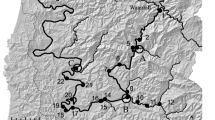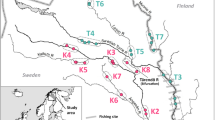Abstract
We tested signals of historical reductions in effective population size within populations of sockeye salmon Oncorhynchus nerka returning to Bristol Bay, Alaska, to examine the roles that ecotype, migration obstacles, and drainage might play in the highly variable production of the Kvichak River drainage. We collected data for eight microsatellite loci from ∼100 fish at each of 16 locations within the Kvichak River drainage and five locations within the more productively stable Naknek River drainage. Pair-wise exact tests were used to group similar collections within ecotype, within drainage, and above and below migration obstacles. After grouping, collections represented independent populations for further analyses. We examined the number of alleles per locus, mean ratio of the number of alleles to the range in allele size, heterozygosity excess, and gametic disequilibrium as measures of reduction-in-population-size events. Number of alleles per locus revealed the largest number of significant differences. Tributary populations showed a stronger signal consistent with reduced effective population size than did beach populations within the Kvichak River drainage. Kvichak River drainage populations showed a stronger signal consistent with reduced effective population size than did the Naknek River drainage populations. Populations above migration obstacles showed signals consistent with reduction in historical population sizes in multiple measures indicating some of these reductions may be severe enough to qualify as demographic bottlenecks.
Similar content being viewed by others
References
Allendorf, F.W. 1986. Genetic drift and the loss of alleles versus heterozygosity. Zool. Biol. 5: 181–190.
Allendorf, F.W. & L.W. Seeb. 2000. Concordance of genetic divergence among sockeye salmon populations at allozyme, nuclear DNA, and mitochondrial DNA markers. Evolution 54: 640–651.
Bentzen, P., J.B. Olsen, J.E. McLean, T.R. Seamons & T.P. Quinn. 2001. Kinship analysis of Pacific salmon: Insights into mating, homing, and timing of reproduction. J. Hered. 92: 127–136.
Blair, G.R., D.E. Rogers & T.P. Quinn. 1993. Variation in life history characteristics and morphology of sockeye salmon in the Kvichak River system, Bristol Bay, Alaska. Trans. Am. Fish. Soc. 122: 550–559.
Chakraoborty, R. & O. Leimar. 1987. Genetic variation within a subdivided population. pp. 89–120. In: N. Ryman & R. Utter (ed.) Population Genetics and Fishery Management, University of Washington Press, Seattle.
Cornuet, J.M. & G. Luikart. 1996. Description and power analysis of two tests for detecting recent population bottlenecks from allele frequency data. Genetics 144: 2001–2014.
Forester, R.E. 1968. The sockeye salmon, Oncorhynchus nerka. Fish. Res. Board Can. Bull. 162: 422 pp.
Frankham, R. 1995. Effective population size/adult population size ratios in wildlife: A review. Genet. Res. 66: 95–107.
Garza, J.C. & E.G. Williamson. 2001. Detection of reduction in population size using data from microsatellite loci. Mol. Ecol. 10: 305–318.
Geiger, H.J., W.W. Smoker, L.A. Zhivotovsky & A.J. Gharrett. 1997. Variability of family size and marine survival in pink salmon (Oncorhynchus gorbuscha) has implications for conservation biology and human use. Can. J. Fish. Aquat. Sci. 54: 2684–2690.
Goudet, J., M. Raymond, T. de Meeus & F. Rousset. 1996. Testing differentiation in diploid populations. Genetics 144: 1933–1940.
Heath, D.D., C. Busch, J. Kelly & D.Y. Atagi. 2002. Temporal change in genetic structure and effective population size in steelhead trout (Oncorhynchus mykiss). Mol. Ecol. 11: 197–214.
Hendry, A.P., F.E. Leonetti & T.P. Quinn. 1995. Spatial and temporal isolating mechanisms-the formation of discrete breeding aggregations of sockeye salmon (Oncorhynchus nerka). Can. J. Zool. 73: 339–352.
Leberg, P.L. 2002. Estimating allelic richness: Effects of sample size and bottlenecks. Mol. Ecol. 11: 2445–2449.
Leonetti, F.E. 1997. Estimation of surface and intragravel water flow at sockeye salmon spawning beaches in Iliamna Lake, Alaska. N. Am. J. Fish. Manag. 17: 194–201.
Luikart, G., F.W. Allendorf, J.-M. Cornuet & W.B. Sherwin. 1998. Distortion of allele frequency distributions provides a test for recent population bottlenecks. J. Hered. 89: 238–247.
Nei, M., T. Maruyama & R. Chakraborty. 1975. The bottleneck effect and genetic variability in populations. Evolution 29: 1–10.
Olsen, J.B., S.L.Wilson, E.J. Kretschmer, K.C. Jones & J.E. Seeb. 2000. Characterization of 14 tetranucleotide microsatellite loci derived from sockeye salmon. Mol. Ecol. 9: 2185–2287.
Olsen, J.B., C. Habicht & J.E. Seeb. 2004. Moderately and highly polymorphic microsatellites provide discordant estimates of population divergence in sockeye salmo, Oncorhynchus nerka. Environ. Biol. Fish. 69: 261–273.
Pimm, S.L., J.L. Gittleman & G.F. McCracken. 1989. Plausible alternatives to bottlenecks to explain reduced genetic diversity. Trends Ecol. Evol. 4: 176–178.
Quinn, T.P. & M.T. Kinnison. 1999. Size-selective and sexselective predation by brown bears on sockeye salmon. Oecologia 121: 273–282.
Raymond, M. & F. Rousset. 1995. GENEPOP (version 1.2): Population genetics software for exact tests and ecumenicism. J. Hered. 86: 248–249.
Rice, W.R. 1989. Analyzing tables of statistical tests. Evolution 4: 223–225.
Rousset, F. & M. Raymond. 1995. Testing heterozygote excess and deficiency. Genetics 140: 1413–1419.
Seeb, L.W., C. Habicht, W.D. Templin, K.E. Tarbox, R.Z. Davis, L.K. Brannian & J.E. Seeb. 2000. Genetic diversity of sockeye salmon of Cook Inlet, Alaska, and its application to management of populations affected by the Exxon Valdez oil spill. Trans. Am. Fish. Soc. 129: 1223–1249.
Selifonov, M.M. 1987. Influence of environment on the abundance of sockeye salmon (Oncorhynchus nerka) from the Ozernaya and Kamchatka Rivers. pp. 125–128. In: H.D. Smith, L. Margolis & C.C. Wood (ed.) Sockeye Salmon (Oncorhynchus nerka) Population Biology and Future Management, Can. Spec. Publ. Fish. Aquat. Sci. 96.
Smouse, P.E. & J.V. Neel. 1977. Multivariate analysis of gametic disequilibrium in the Yanomama. Genetics 85: 733–752.
Spencer, C.C., J.E. Neigel & P.L. Leberg. 2000. Experimental evaluation of the usefulness of microsatelliteDNAfor detecting demographic bottlenecks. Mol. Ecol. 9: 1517–1528.
Spong, G. & L. Hellborg. 2002. A near-extinction in lynx: Do microsatellite data tell the tale? Conservation Ecology 6: 15 [online] URL: http://www.consecol.org/vol6/iss1/art15.
Waldick, R.C., S. Kraus, M. Brown & B.N. White. 2002. Evaluating the effects of historic bottleneck events: An assessment of microsatellite variability in the endangered, North Atlantic right whale. Mol. Ecol. 11: 2241–2249.
Waples, R.S. 1990. Conservation genetics of Pacific salmon. II. Effective population size and the rate of loss of genetic variability. J. Hered. 81: 267–276.
Waples, R.S. & P.E. Smouse. 1990. Gametic disequilibrium analysis as a means of identifying mixtures of salmon populations. Am. Fish. Soc. Symp. 7: 439–458.
Withler, R.E., K.D. Le, R.J. Nelson, K.M. Miller & T.D. Beacham. 2000. Intact genetic structure and high levels of genetic diversity in bottlenecked sockeye salmon (Oncorhynchus nerka) populations of the Fraser River, British Columbia, Canada. Can. J. Fish. Aquat. Sci. 57: 1985–1998.
Wood, C.C. 1995. Life history variation and population structure in sockeye salmon. Am. Fish. Soc. Symp. 17: 195–216.
Wright, S. 1978. Evolution and the Genetics of Populations. Volume 4: Variability Within and Among Natural Populations, The University of Chicago Press, Ltd, London.
Author information
Authors and Affiliations
Rights and permissions
About this article
Cite this article
Habicht, C., Olsen, J.B., Fair, L. et al. Smaller Effective Population Sizes Evidenced by Loss of Microsatellite Alleles in Tributary-Spawning Populations of Sockeye Salmon from the Kvichak River, Alaska drainage. Environmental Biology of Fishes 69, 51–62 (2004). https://doi.org/10.1023/B:EBFI.0000022887.62009.54
Issue Date:
DOI: https://doi.org/10.1023/B:EBFI.0000022887.62009.54




